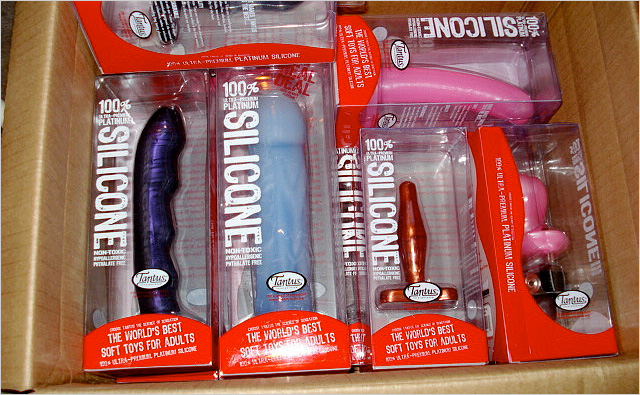The biggest categories of sex toy materials are porous and non-porous.
Porous materials encompass a huge range of materials; some of the more commonly known are branded materials like CyberSkin, Doc Johnson’s UR3, Sil-a-Gel, SEBS, TPR, TPE/Elastomer, Elastomed… The list goes on and on. Clear, jelly-like, stretchy materials are always porous. Though they can also be opaque, it’s a safe bet that if your new sex toy is clear and stretchy, it’s porous.

Toxic sex toys and false labeling: real silicone?
It’s important to note that Sil-A-Gel does not actually contain any silicone. Screaming O, a company whose products are made of SEBS recently admitted that their products do not contain silicone and will be changing their packaging over time. If you see a product claiming to be made of “SEBS Silicone” it does not actually contain any silicone and is porous.
There are varying levels of porosity and overall stability in these materials, with cheaper options usually being more porous, breaking down faster and more likely to contain materials that are toxic to the body. Some sex toys are already breaking down in the packaging before you buy them, and will give off a noxious smell and greasy residue.
Toxic toys can cause issues ranging from irritation and yeast infections to chemical burns, which is a big concern—and something many manufacturers get away with because there is no regulation and little research going into this. More expensive materials will generally be more stable and less porous, but this isn’t always the case.
Either way, porous materials can harbor dirt, bacteria, mold, and STIs. Using a porous toy during a bacterial or yeast infection can cause the toy to re-infect you at a later date, and you shouldn’t use them in more than one orifice or with more than one person without a condom. You can never truly clean porous materials, so keeping it to yourself is generally a good idea. You should also know that if you’re experiencing irritation to a toy that using a condom won’t help- though they will keep STIs and sperm out, they have small pores and people who experience irritation often will continue to experience it, even with a condom.
With sex toys, non-porous is body safe
Non-porous materials are much simpler: The more common ones are silicone, glass, ABS hard plastic and metal. Wood, ceramic and stone are also used, but are less common.

Silicone is the only soft non-porous material used to make sex toys, and you’ll find it very firm, very soft, or in “dual density” form, with a squishy exterior and firm interior and base—and it’ll be everywhere from the coating on high-end luxury vibrators to cock rings. Because it’s moldable, it can come in a huge range of sizes, shapes, and colors.
Glass toys will never break during use, contrary to popular urban legends. The one’s you’ll usually find are made of borosilicate—also known as Pyrex—which is more resistant to impact and temperature shifts than it's cousin, Soda Lime, which is used to make many handblown glass toys. These are still very durable because they’re solid glass. Both can be placed in cool or warm water for temperature play, and have smooth, frictionless surfaces.
Metal is smooth and frictionless like glass, and when it comes to sex toys, you’ll usually find stainless steel, aeronautic grade aluminum, and some luxury options like gold, platinum and sterling silver. These range in weight, but stainless steel is the most common and will usually be very heavy, which some people enjoy. Be careful when buying stainless steel products: if the price seems less than similar options, it’s probably just plated in stainless steel, with a core of a cheap, usually impure, metal. In these instances, the stainless plating can wear off and potentially cause an allergic reaction. Or, the product might break. It’s better to invest in a medical grade, high quality option that will last a lifetime.
Body safe wooden sex toys can be tricky to find, as many sellers make wooden sex toys and treat them with "natural" or "food safe" coatings that are not necessarily body safe. Also, many natural finishes can be made of allergy-causing nut or grain oils.
Always know what your toys are made of and always buy non-toxic body safe sex toys. The material also will change how you clean your sex toy, and whether it will last a long time or need to be thrown out after a few months. Whether you have experienced irritation from sex toys or just want to avoid unknown chemicals, it's essential to know what's in your sex toys.
Caitlin is a writer, sex educator, consultant, and product reviewer who focuses primarily on issues of sex toy and accessory safety, pleasure, sexuality, gender, and more. You can learn more, or ask any questions, at their website- www.sex-ational.com.


Join the conversation
You are posting as a guest. If you have an account, sign in now to post with your account.
Note: Your post will require moderator approval before it will be visible.